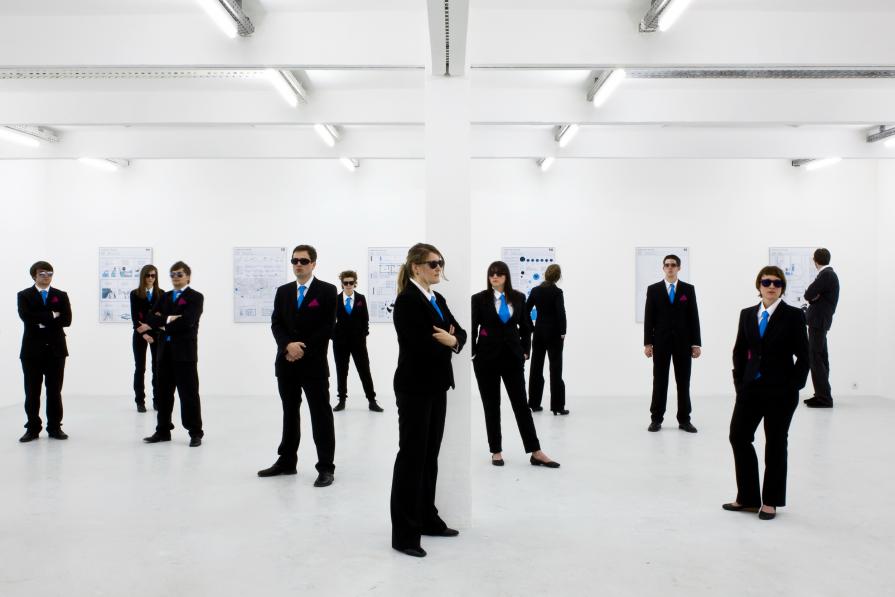Blasbichlers Twentyone
Blasbichlers Twentyone was conceived as an academic art/architecture experiment to investigate the marginalization of the architect, its social role, its role within the “urban-industrial complex”, the product-value architecture is able to achieve, the mass of new architects produced by universities trying to find legitimation, the potentials of role play and last but not least the bold attempt to run an academic course as a temporary profit oriented business model.
THE PLAN
At first glance the attempt to plan a bank heist might sound like a post-adolescent prank, stupid, even irresponsible. But it's not. Blasbichlers Twentyone is an endeavour that calls most of the core competences of an architect. i.e. research and value the site, find out weak and strong aspects, think, imagine, anticipate, sense and develop a concept, sketch, think, design, rethink, reimagine etc., prepare action plan documentation, plan the time schedule, the costs. And well, also an escape plan was asked.
THE BANKS
You can't do without banks in prevailing social systems, can you? However, banks are not the enemy; rather they have become the fortresses of desires, the keeper of dreams, the dealers of the immaterial, hardly accessible and locked-off from the public, although propagating transparency. From this point of view banks are a rewarding topic for research, also for architects. Banks constitute an almost invisible net of power structures. To examine these structures is to bring to light something which has been buried and set out of balance. Unfolding a system is not a crime, it rather adjusts the attention.
ROLE PLAY
Before the actual task the students were asked to present a paper of the working methods of a personality of their choice. The choices ranged from leading figures from politics, sports, arts, economy, science, etc. These fictional personas have been called alter-egos. Subsequently and together with their alter-egos, the students had to break the task.
THE TASK
Develop a bank robbery plan for a bank branch within the city limits (of Innsbruck). Use only information you find out yourself. Your alter-ego is your team mate, listen to what he/she says. Do not tell bank staff who you are and what you intend to do. Identify weak points of the chosen bank branch. Develop a concept to detract assets from the bank according to the weaknesses identified. Include action-, time-, and escape plan in a uniformed poster document. Use graphic design and visual communication techniques in order to provide a viable instructions manual document. Calculate or estimate the potential loss of assets.
THE TARGETS
The task was not to steal but to examine and exploit the weak points for the purpose to provide a feasible emergency plan. The targets ranged from assets like time, space, image, future clients, electric power, etc. up to the one student, who celebrates with unbelievable virtuosity the theft of the typical chained ball pen on the counter, an icon of worthlessness and petty-minded communication strategies. In any case, cash money assets were of a subordinate interest.
LEGAL ASPECTS
The single banks were not advised nor involved in the project because an authentic general framework had to be guaranteed. The University's legal department approved the project with some formal and privacy restrictions. Any time you put to the test your own imagination of things with the prevailing parameters of the real, things become potentially illegal.
THE SHOW
The results have been exhibited in an art gallery in Innsbruck. That was the moment where bank representatives and safety officers came to see the poster size "emergency plans" for the first time. The key question during the exhibition was: is this immaterial architecture, are those fictional scenarios, the information provided by unsolicited architects, is imagination, is architecture itself of any monetary value? It was. Most of the banks appreciated the outcomes and gave a financial contribution.
ARCHITECTURE?
Architecture is much more than designing a building, it's about the making of the imagination, the materialization of desire. In this sense architecture is more related to the arts and the financial sector than one might think. The arts, banking and architecture are of a kin.
***********
Blasbichlers Twentyone (2011)
Conducted at: Institute of Design, Studio1 – University of Innsbruck
B21 collective: Stefanie Budweiser, Andreas Damhofer, Christian Flatscher, Christian Fontana, Sabine Gubi, Christoph Huebser, Georg Ladurner, Daniel Link, Martin Mackowitz, Martin Neugebauer, Matthias Obermoser, Clemens Pletzer, Martina Reiter, David Schildberger, Lea Spindler, David Schreyer, Barbara Springer, Kerstin Teubner, Andreas Trentinaglia, Thomas Wirtl, Christiane Zangerle
Directed by: Armin Blasbichler
Material: 21 framed digital print graphics, 70x100cm







Comments 0
Say something